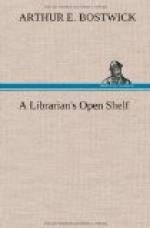Probably this realization has come earlier and more fully to the library, because its educational function is directed so much more upon adults. The library is coming to be our great continuation school—an institution of learning with an infinity of purely optional courses. It may open its doors to any form of adult social activity.
There are forms of activity proper to a social center that require special apparatus or equipment. These may be furnished in a building erected for the purpose, as are the Chicago fieldhouses. Here we have swimming-pools, gymnasiums for men and for women, and all the rest of it. A branch library is included and some would house the school also under the same roof. We may have to wait long for the general adoption of such a composite social center. Our immediate problem is to supply an immediate need by using means directly at our disposal. And it is remarkable how many kinds of neighborhood activity may take place in a room unprovided with any special equipment. A brief glance over our own records for only a few months past enables me to classify them roughly as athletic or outdoor, purely social, educational, debating, political, labor, musical, religious, charitable or civic, and expository, besides many that defy or elude classification.
The athletic or outdoor organizations include the various turning or gymnastic clubs and the Boy and Girl Scouts; the social organizations embrace dancing-classes, “welfare” associations, alumni and graduate clubs of schools and colleges, and dramatic clubs; the educational, which are very numerous, reading circles, literary clubs galore, free classes in chemistry, French, psychology, philosophy, etc., and all such organizations as the Jewish Culture Club, the Young People’s Ethical Society, the Longan Parliamentary Class, and the Industrial and Business Women’s Educational leagues. Religious bodies are parish meetings, committees of mission boards, and such organizations as the Theosophical Society; charitable or civic activities include the National Conference of Day Nurseries, the Central Council of Civic Agencies, the W.C.T.U., playground rehearsals for the Child Welfare Exhibit, and the Business Men’s Association; and the Advertising Men’s League; musical organizations embrace St. Paul’s Musical Assembly, the Tuesday Choral Club, etc. Among exhibitions are local affairs such as wild flower shows, an exhibit




